Gas-premeable laminated sheet
a technology of laminated sheet and gas-premeable sheet, which is applied in the direction of transportation and packaging, synthetic resin layered products, chemistry apparatus and processes, etc., can solve the problems of high cost, high cost, and inability to reuse work clothes, and achieves high cost, low production cost, and high gas permeability.
- Summary
- Abstract
- Description
- Claims
- Application Information
AI Technical Summary
Benefits of technology
Problems solved by technology
Method used
Image
Examples
example 1
[0023] Polyethylene was drawn under heating into a polyethylene film having a thickness of about 15 μm. As shown in FIG. 1, after drawing, nonwoven fabrics 1, each having a thickness of about 30 μm, composed of polyethylene were laminated on upper and lower sides of a polyethylene film 2 so that the polyethylene film 2 was interposed between the nonwoven fabrics 1. The resulting laminate was subjected to pressure-bonding with rollers to produce a gas-permeable laminated sheet according to the present invention. Then, the nonwoven fabrics 1 were carefully peeled off to separate only the polyethylene film 2. The surface state of the polyethylene film 2 was observed with an optical microscope.
[0024]FIG. 2 is an optical-microscope image (100×) of a surface of the polyethylene film after producing the gas-permeable laminated sheet. FIG. 3 is a schematic view of the surface state of the polyethylene film on the basis of FIG. 2.
[0025] As shown in FIGS. 2 and 3, on the surface of the poly...
example 2
[0026] Nonwoven fabrics, each having a thickness of about 30 μm, composed of polyethylene were laminated on upper and lower sides of a polyethylene film having a thickness of about 15 μm so that the polyethylene film was interposed between the nonwoven fabrics as in Example 1. The resulting laminated sheet was drawn in the two directions with a tenter to produce a gas-permeable laminated sheet according to the present invention.
[0027] Then, in the obtained gas-permeale laminated sheet, the nonwoven fabrics were carefully peeled off to separate the polyethylene film. The surface state of the polyethylene film was observed with an optical microscope.
[0028] As a result of observation, similar to the gas-permeable laminated sheet produced in Example 1, on the surface of the polyethylene film after producing the gas-permeable laminated sheet, many fiber marks were formed at areas where the polyethylene film was in contact with the fibers constituting the nonwoven fabrics during laminat...
examples 3 and 4
[0029] Nonwoven fabrics composed of polyethylene (METSUKE (the weight of each fabric): 22 g / m2) were laminated on upper and lower sides of a polyethylene film (thickness: about 15 μm) so that the polyethylene film was interposed between the nonwoven fabrics as in the above-described Examples. This three-layer laminate was subjected to pressure-bonding with pressure rollers under appropriate conditions to produce a gas-permeable laminated sheet according to the present invention (Example 3). Alternatively, the three-layer laminate was subjected to pressure-bonding with pressure rollers under appropriate conditions while being drawn with a tenter to produce a gas-permeable laminated sheet according to the present invention (Example 4).
[0030] With respect to each of the resulting gas-permeable laminated sheets produced in Examples 3 and 4, water-pressure resistance (mm) according to Japanese Industrial Standard (JIS) L 1092A, air permeability (cm3 / cm2 / s) according to JIS L 1096A, and ...
PUM
| Property | Measurement | Unit |
|---|---|---|
| Diameter | aaaaa | aaaaa |
| Diameter | aaaaa | aaaaa |
| Diameter | aaaaa | aaaaa |
Abstract
Description
Claims
Application Information
 Login to View More
Login to View More - R&D
- Intellectual Property
- Life Sciences
- Materials
- Tech Scout
- Unparalleled Data Quality
- Higher Quality Content
- 60% Fewer Hallucinations
Browse by: Latest US Patents, China's latest patents, Technical Efficacy Thesaurus, Application Domain, Technology Topic, Popular Technical Reports.
© 2025 PatSnap. All rights reserved.Legal|Privacy policy|Modern Slavery Act Transparency Statement|Sitemap|About US| Contact US: help@patsnap.com



